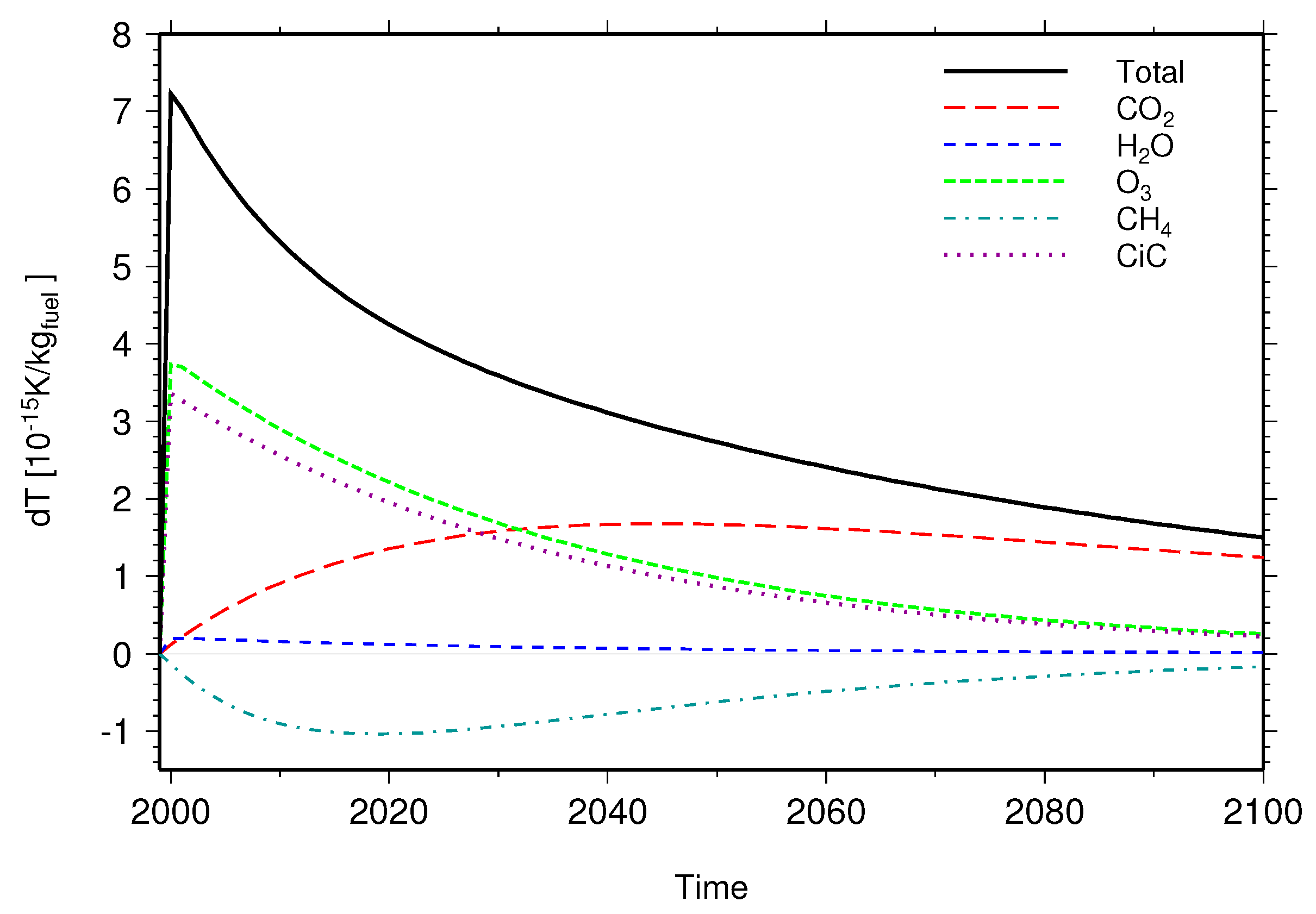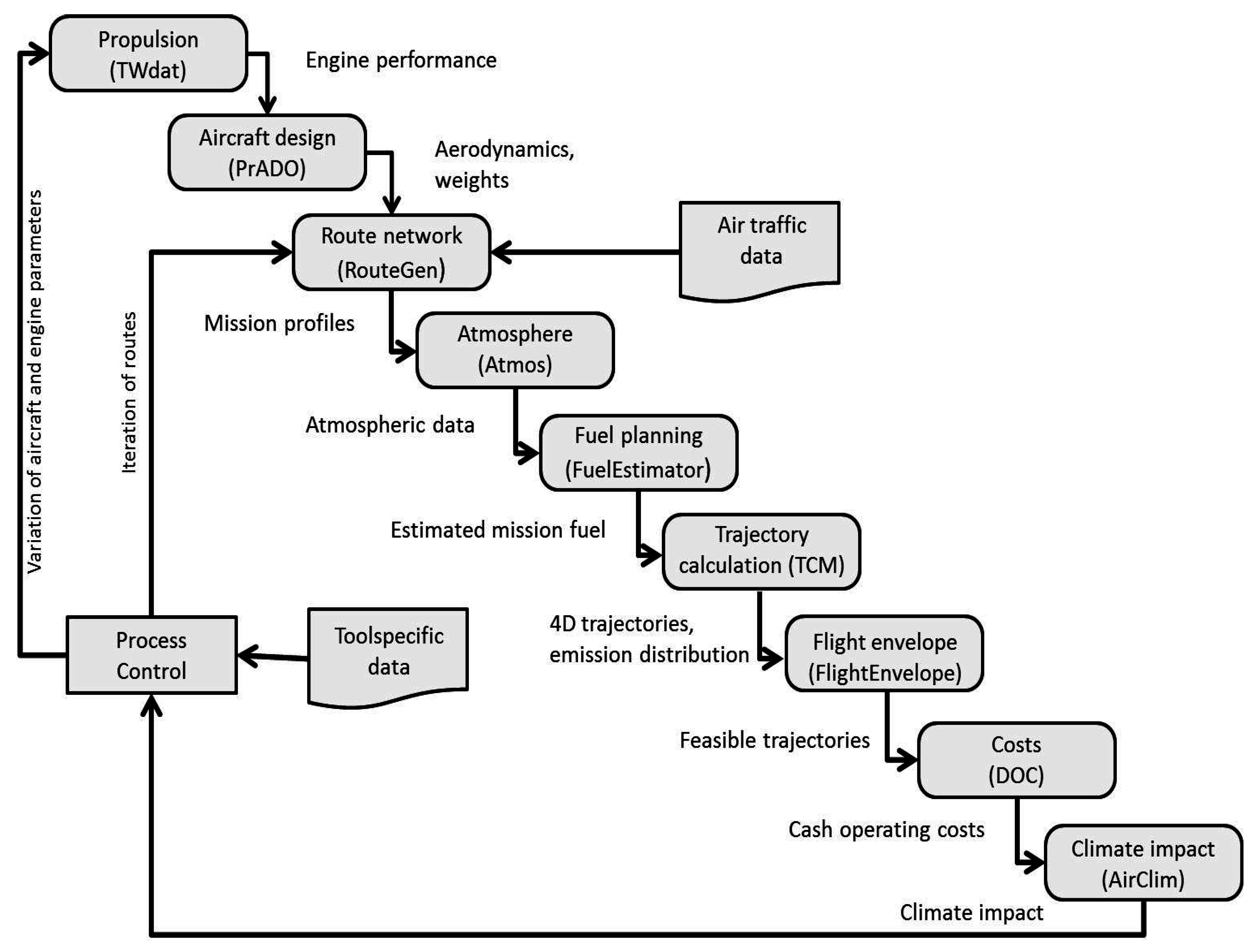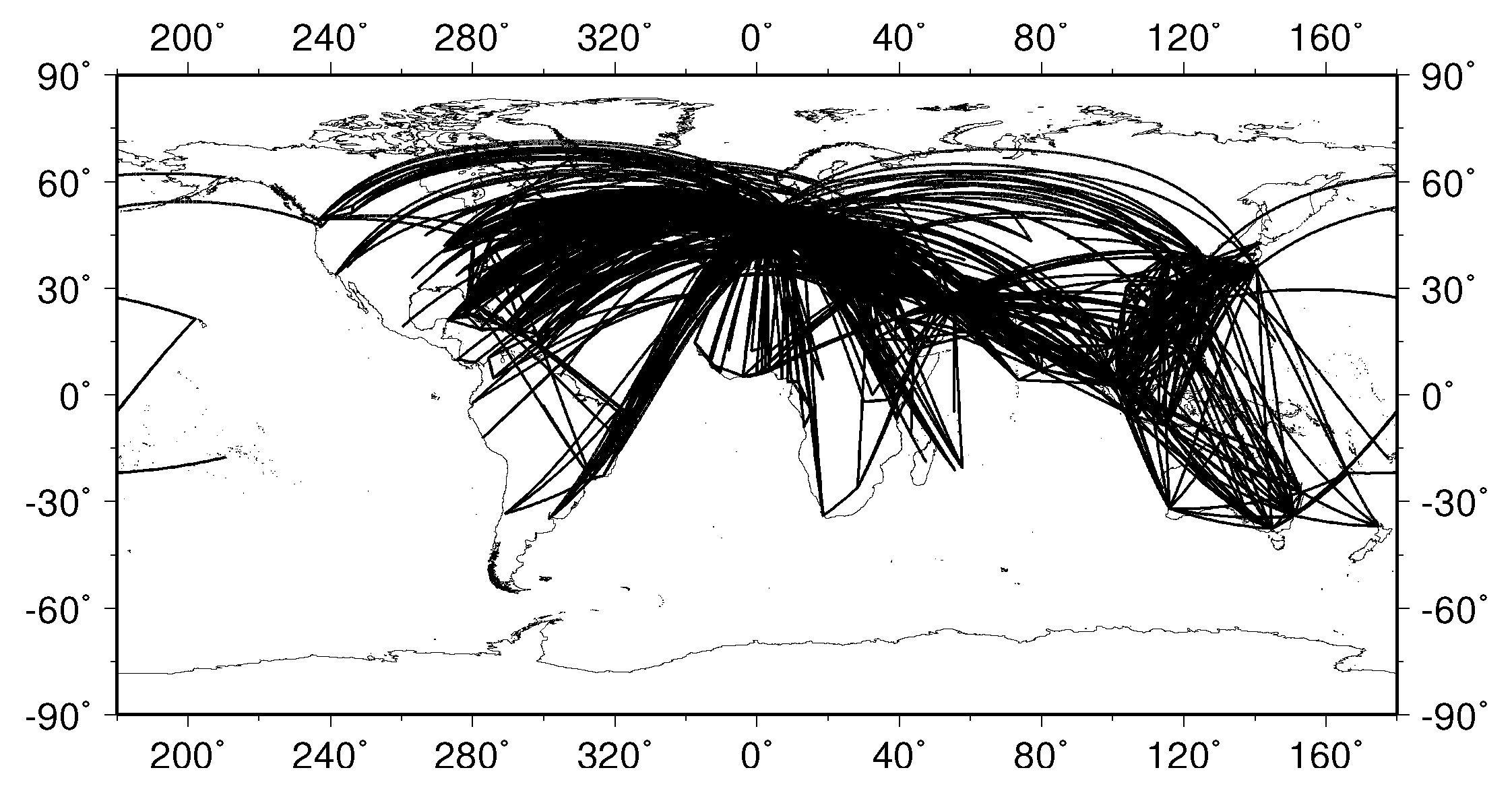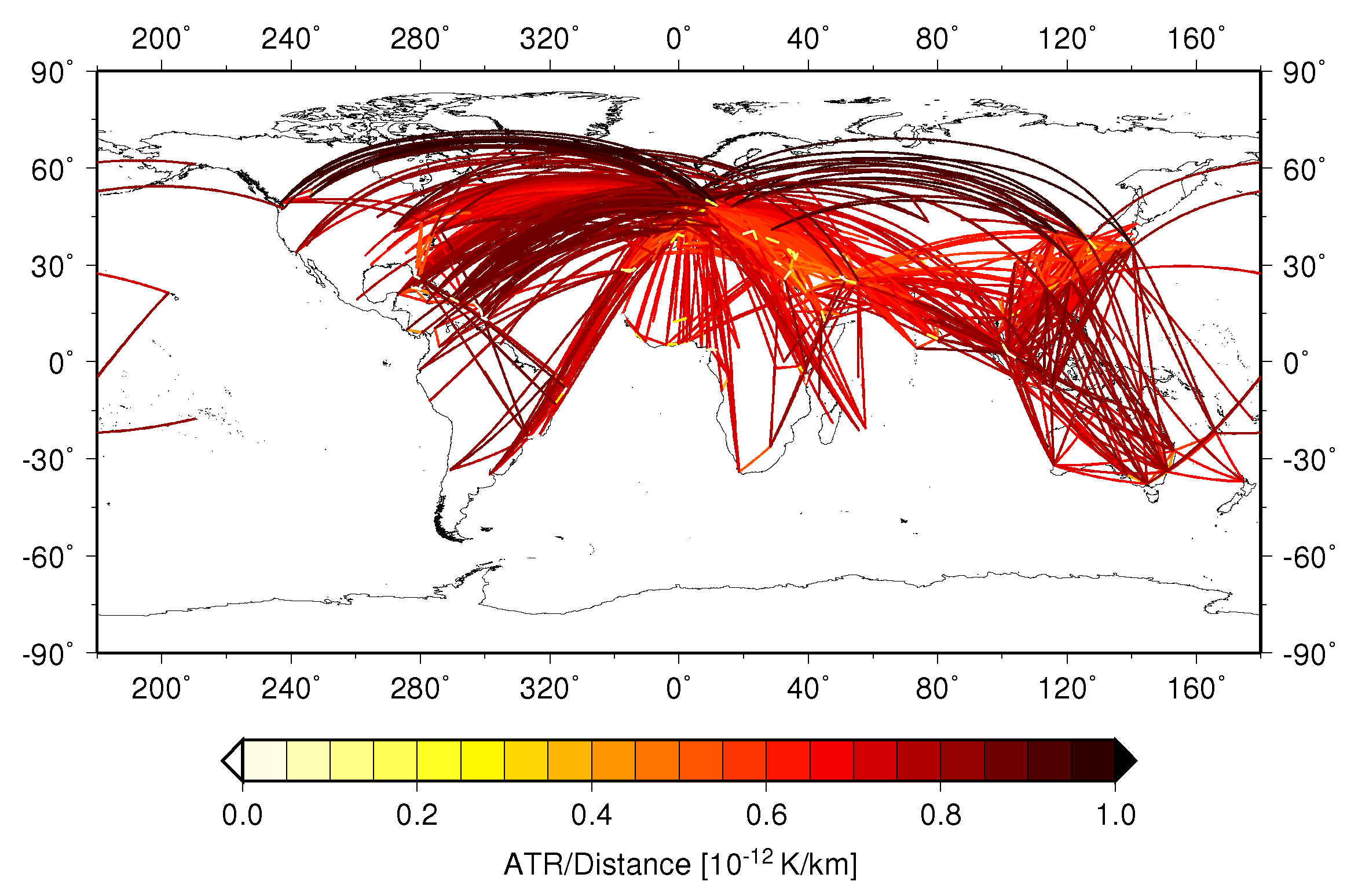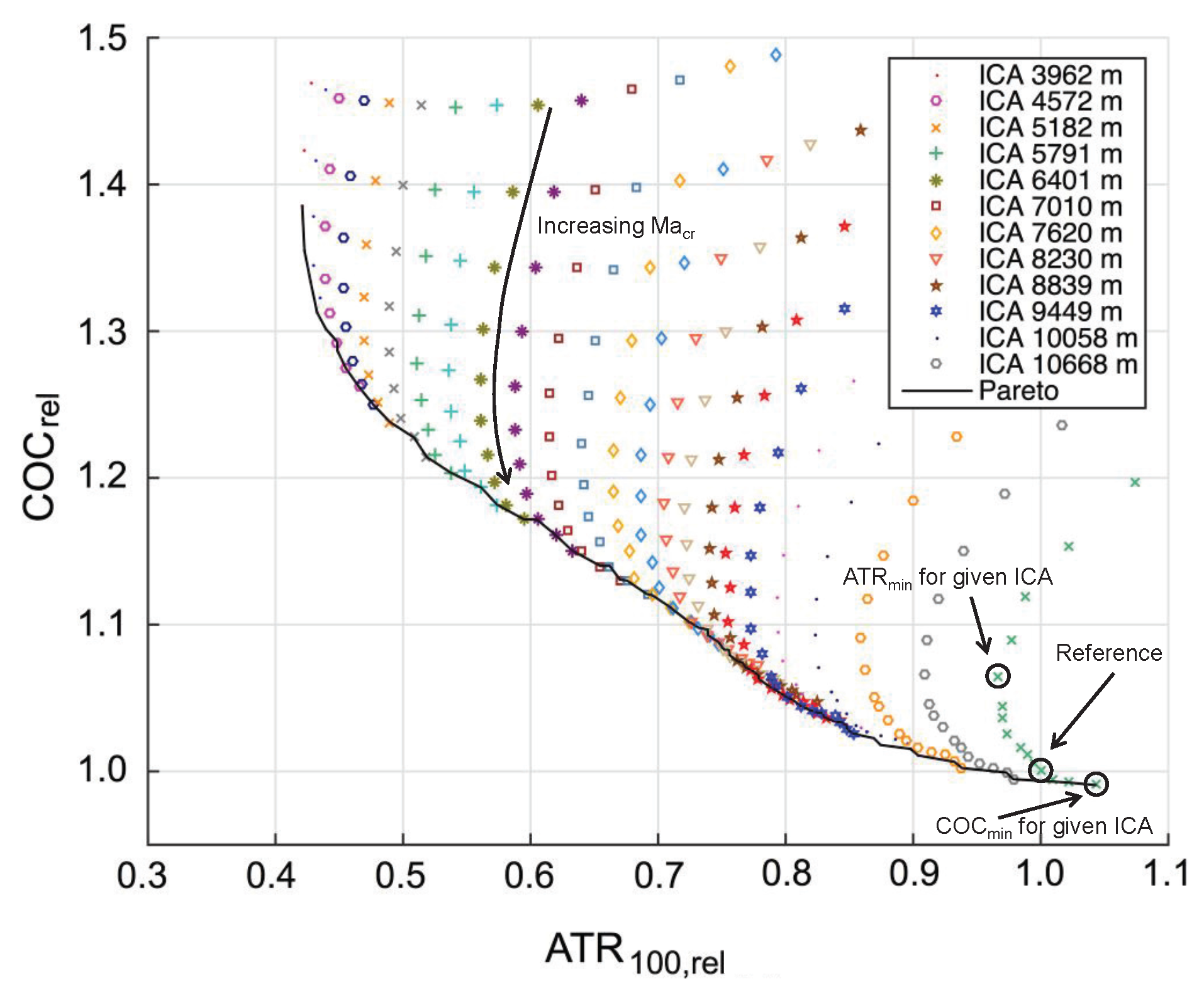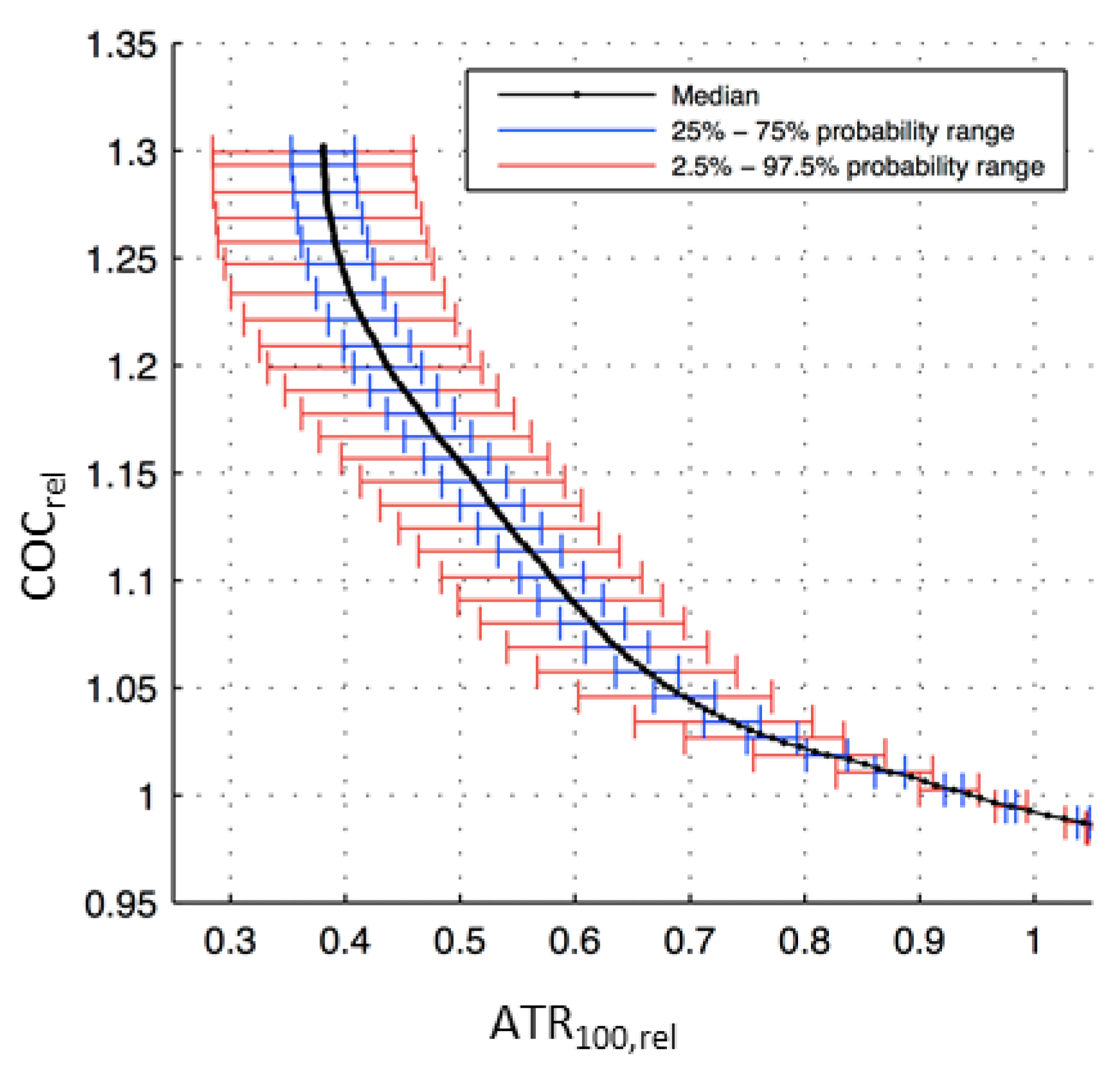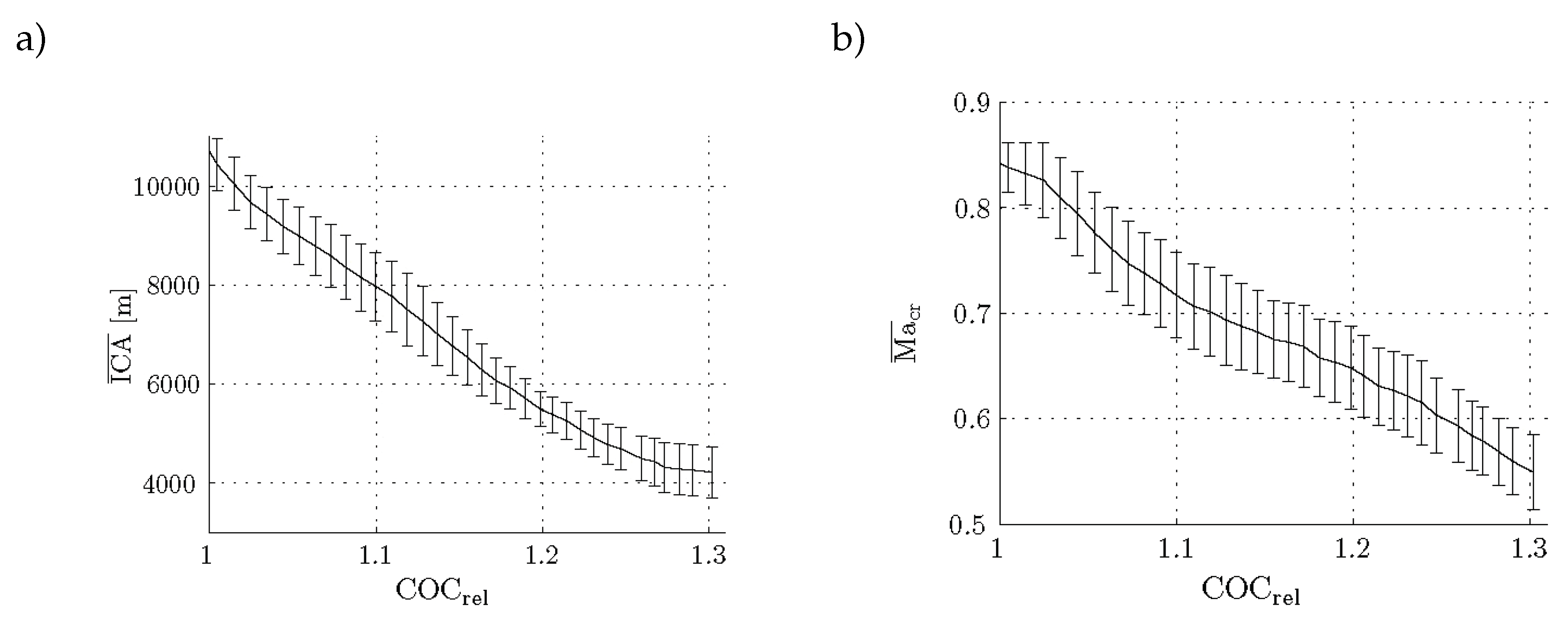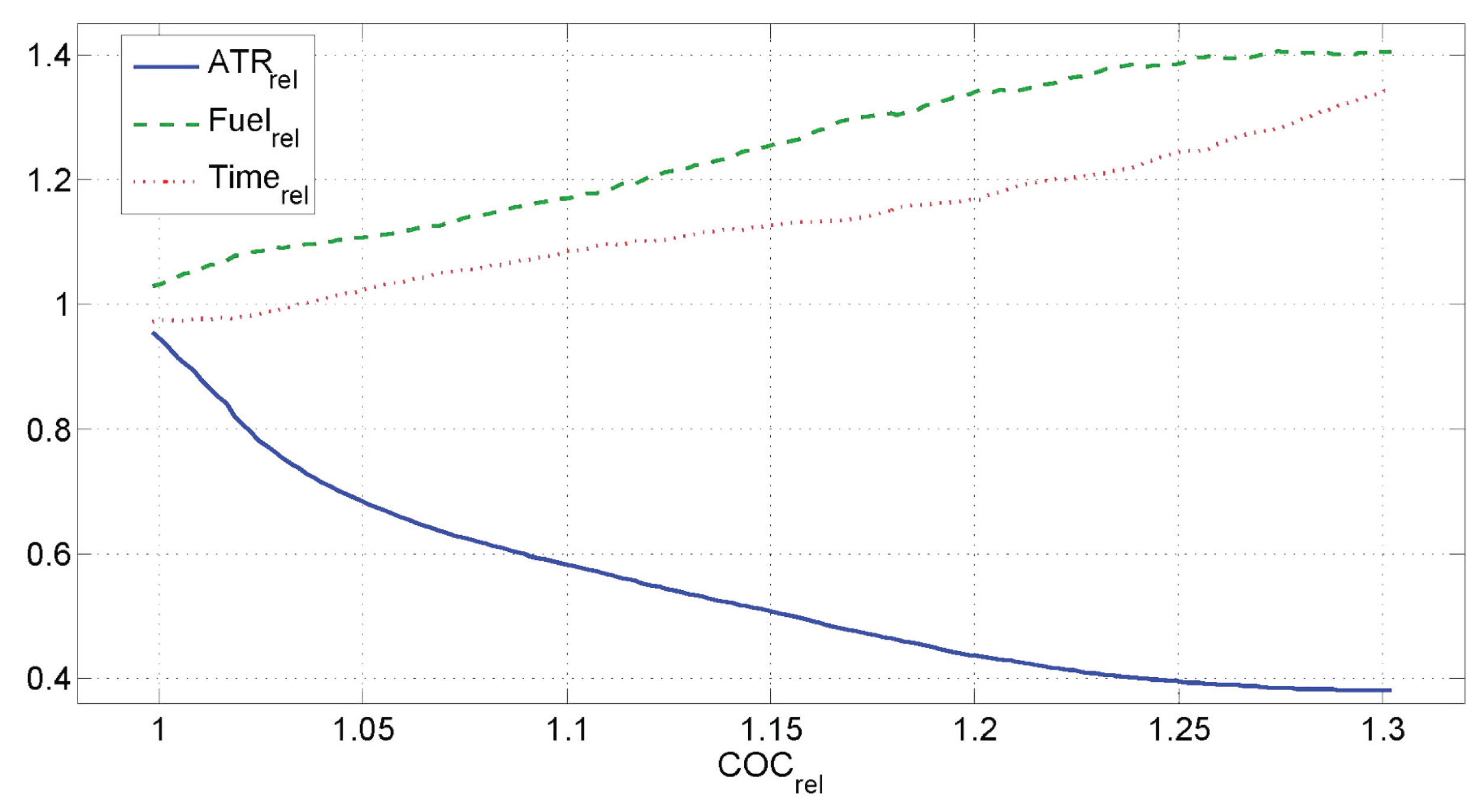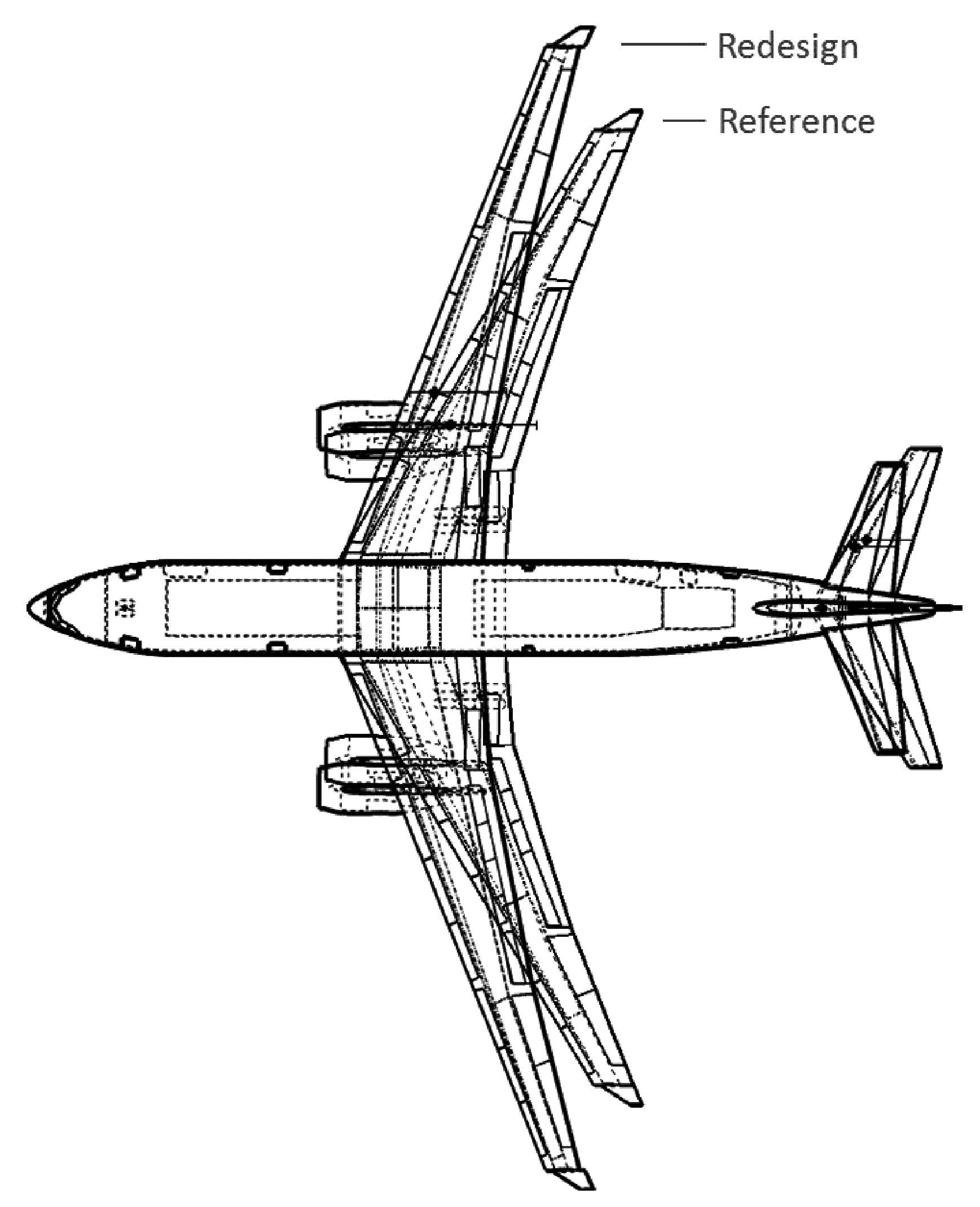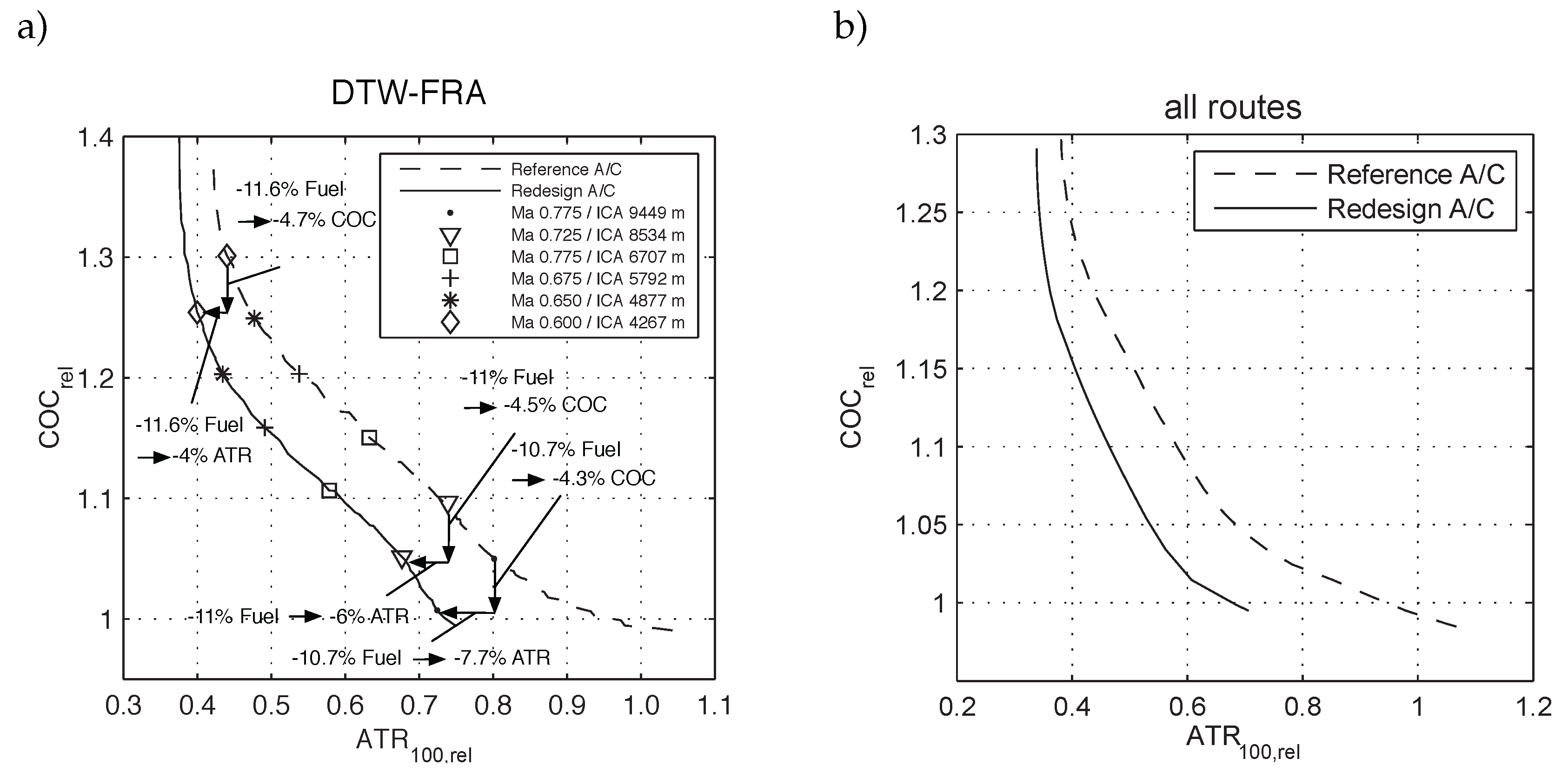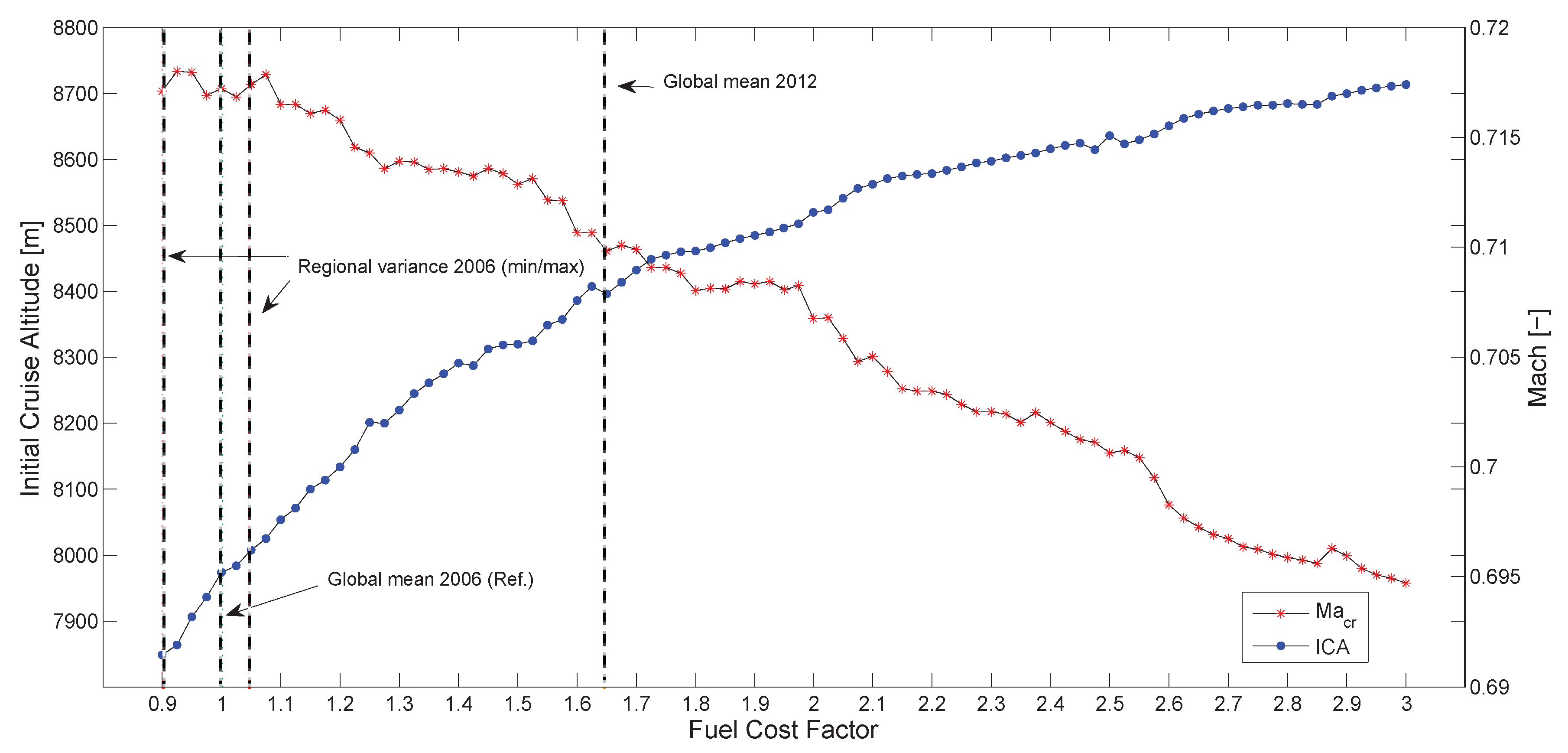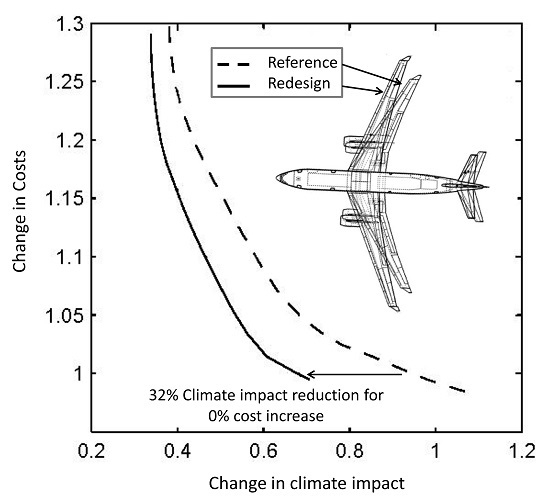1. Introduction
The environmental impact of aviation, in terms of gaseous pollutants and noise emissions, becomes more and more important to society. Aviation emissions alter the radiative characteristics of the Earth-atmosphere system and lead to an increase of global surface temperature. Aviation was assessed to account for a total radiative forcing (RF) of 78 mW·m
(38–139 mW·m
, 90% likelihood range) in 2005, including the impact from aviation-induced cirrus clouds [
1].
Commercial aviation has experienced a steady growth of travel rates over the last decades and is expected to grow approximately 4.6% per year in terms of passenger kilometers in the next 20 years without further political measures [
2]. This will largely surpass the typical annual fuel efficiency improvements of 1%–2% [
2]. Along with this development, continuous improvements in transport efficiency also were achieved. However, despite these technological advances the growing demand of commercial air transport and the related number of conducted flights led to an increase in emissions and considerable changes of greenhouse gases, aerosols and induced cloudiness.
The rise of annual emission rates and induced cloudiness will hence further increase the climate impact from aviation. The Advisory Council for Aeronautical Research in Europe (ACARE) states, in this sense, that a socially- and climate-compatible air transportation system is required for a sustainable development of commercial aviation. Therefore, climate impact mitigation strategies have to be developed based on comprehensive assessments of the different impacting factors and reduction potentials.
In the past, a couple of mitigation strategies were analyzed. Many of them focus on a change in flight altitude to reduce the impact of contrails (e.g., [
3,
4,
5,
6,
7]); others include additional effects, such as the climate impact from nitrogen oxide emissions (NO
) (e.g., [
8,
9,
10]). These studies have a focus on the climate impact, but apply simplified assumptions for aircraft performance. In addition, there are several studies that focus on aircraft design, but use simplified assumptions for the climate impact assessment (e.g., [
11,
12,
13]).
The systematic assessment of aviation climate impact and the identification of the most suitable mitigation strategies represents a very challenging task. The atmospheric response to anthropogenic perturbations involves complex interdependent processes of very different natures acting on different spatial and temporal scales. The global climate impact from air traffic varies not only with the amount and type of emitted species, but also with altitude, location (longitude and latitude), time of day and season and atmospheric conditions. Further, changes in current flight procedures and aircraft design are likely to propagate to other areas of air traffic, which might provoke penalties for certain system stakeholders. Although environmental sustainability becomes increasingly important for society, current air traffic is so far purely cost driven. In this sense, nowadays, aircraft are designed for minimum operating costs: the airline operates the aircraft such that the highest revenues at the lowest possible costs are achieved, and the passenger dominantly chooses his/her flight according the lowest ticket price or best travel comfort. Changes towards improved climate impact of air traffic will often lead to cost penalties that have to be shared by the different stakeholders of the air transport system, those being the aircraft and engine manufacturers, airlines, air traffic management providers, regulatory authorities and not to forget the traveling passenger as customer. This, in turn, leads to a conflict between two basic expectations of society towards air traffic: the environmental sustainability vs. the price of air travel. It is hence essential to identify climate impact mitigation strategies with the best relation of benefit and costs.
The assessment of options to reduce the climate impact from aviation by operational and technological measures requires expert knowledge from different aviation disciplines and adequate models that sufficiently incorporate the driving impact factors. It further requires a comprehensive system analysis approach that integrates the relevant interdependencies for the development of cost-efficient mitigation strategies.
Such a comprehensive approach was developed within the DLR (Deutsches Zentrum für Luft- und Raumfahrt, German Aerospace Center) project CATS (Climate-compatible Air Transport System, 2008–2012). In this study, a summary of the project results is presented. A detailed description of the approach and results is given in Koch [
14]. First, we quantify the climate impact mitigation potential and related cost penalty for current aircraft that are operated at different cruise altitudes and speeds. Further, we analyze the additional climate impact mitigation potential and cost improvement resulting from aircraft that are specifically designed for cruise conditions with reduced climate impact.
2. Climate Impact from Aviation
We will now describe the climate impact of aviation, mentioned in
Section 1, in detail. The climate impact from air traffic results from induced cloudiness and concentration changes of atmospheric constituents caused by the emission of carbon dioxide (CO
), nitrogen oxides (NO
), sulfur oxides (SO
), water vapor (H
O) and aerosols [
15]. These atmospheric perturbations change the terrestrial radiation balance and cause an RF that drives the Earth-atmosphere system to a new state of equilibrium through a resulting temperature change.
Table 1 shows the RF estimates for the atmospheric perturbations from aviation in 2005. One of the major perturbations to the atmospheric radiative balance is caused by emitted CO
(28 mW·m
until 2005) [
1], which is a greenhouse gas with lifetimes of up to several thousand years [
15]. Due to its long atmospheric lifetime, CO
is well mixed in the atmosphere, rendering the impact of CO
independent from the location of emission. The impact of CO
can hence only be reduced by aircraft and engine design and operations that lead to reduced fuel burn or alternative fuels.
However, also non-CO
effects have a large impact on the RF, especially from emitted NO
and contrail-induced cloudiness (CiC). The initial effect of NO
emissions from subsonic air traffic released in the upper troposphere and lower stratosphere is that of enhanced formation of ozone (O
) on time scales of weeks to months. Enhanced NO
also depletes methane (CH
) and causes reduced ozone (long-lived O
) on decadal time scales. Both O
and CH
are greenhouse gases. Hence, the net RF from aviation NO
depends on which pathway dominates, and this depends on emission scenarios, background concentrations and the chemical rate coefficients [
17]. Depending on the location of the emission, the net RF of these emissions could be positive or negative [
10]. Here, we take the average net RF of NO
from Lee et al. [
1], which is 12.6 mW·m
, as the impact of short-term O
prevails, in particular for growing emissions. The perturbation lifetime of CH
is about 12 years, whereas O
is a chemically-reactive gas with a comparably short lifetime of 1–3 months in the troposphere [
15]. The impact from NO
emissions on the concentration change of O
and CH
is sensitive to altitude and latitude. The maximum net RF is found at the tropical tropopause and decreases towards lower altitudes and higher latitudes [
18]. Apart from lower amounts of emissions, the net impact of emitted NO
can thus be reduced also by changing flight altitudes.
CiC includes contrails, contrail cirrus clouds and changes in the occurrence and properties of natural cirrus clouds [
19]. Contrails start as line-shaped cirrus clouds, which form when humidity in the exhaust plume exceeds liquid saturation. The humidity increases by mixing of warm and moist exhaust gases with the colder ambient air. Ice particles in the contrails form by freezing of liquid droplets, which condensate on soot particles and other aerosol in the exhaust. Contrails form only in sufficiently-cold air under specific atmospheric conditions and often sublimate within minutes, but may persist for several hours in air masses that are supersaturated with respect to ice [
20,
21]. Under such meteorological conditions and with the presence of shear winds, persistent contrails can spread over large areas, eventually lose their initial linear shape, mix with other contrails and with other cirrus and form “contrail cirrus”. Such clouds often look like natural cirrus, but would not exist without prior formation of contrails. The climate impact of persistent contrails and contrail cirrus depends on their lifetime, time of day, coverage, optical thickness, temperature, Earth albedo and other ambient conditions [
15]. Contrail cirrus clouds may also change the water budget of the surrounding atmosphere and potentially modify the optical properties of natural clouds [
22,
23]. The global average climate impact from CiC has been determined with a global model as 31 mW·m
for the year 2002 [
22] and with a combined model-observation study as 50 (30–80) mW·m
for the year 2006 [
24]. The formation of contrail cirrus can be reduced by avoiding flights through ice supersaturated regions, which usually have relatively small vertical extensions in the order of 500 m [
4,
25]. CiC is expected to warm globally, but may cool regionally during daytime over dark surfaces, such as oceans. This opens further potential for daytime and weather-dependent aviation climate mitigation [
6,
26,
27].
This paper investigates the potential for optimized aircraft design and air-traffic operations to minimize the climate impact of aviation on a climatological basis, regardless of the actual weather situation. Studies on weather-dependent aviation-system optimization are ongoing.
As displayed in
Table 1, further impacts arise from emitted H
O and aerosols, such as soot particles and sulfate droplets [
28]. Whereas sulfate aerosols are estimated to have a cooling impact (−4.8 mW·m
, best estimate) on the radiation budget through scattering and reflecting shortwave radiation, soot particles are accounted to have a direct warming effect (3.4 mW·m
) by absorbing and re-emitting radiation in the long-wave spectrum [
1]. Soot influences the number and size of ice particles in contrails and, hence, the climate impact of contrail cirrus. Soot may also impact ice formation in cirrus clouds. However, the latter effect is still uncertain because it is not fully understood if these particles nucleate ice efficiently [
29,
30]. The estimated impact resulting from H
O emitted at typical subsonic flight levels is comparatively small (2.8 mW·m
) due to its small influence on the atmospheric background concentration of H
O [
1].
The provoked atmospheric perturbations alter the global average temperature on different time scales.
Figure 1 exemplary shows the temporal evolution of global average temperature change
for the forcing agents resulting from a one-year pulse emission in 2000 based on the REACT4C (Reducing Emissions from Aviation by Changing Trajectories for the benefit of Climate) emission inventory [
31]. While the perturbations with short lifetimes (e.g., contrails and O
) decay relatively fast, long-lived components (e.g., CO
and CH
) show a considerable impact over decades, even centuries (CO
). While the RF of CiC was the highest in
Table 1, the temperature change of ozone is larger than that of CiC due to the different climate sensitivities: we assume for O
climate sensitivity of 1.0 K·W
m
and for CiC 0.43 K·W
m
according to Ponater et al. [
32]. These values are based on a few studies only and, hence, require further research.
As the global average temperature response has a closer relation to weather events and climatic consequences than RF, it is more suited to measuring the future anthropogenic climate impact. The atmospheric response to the different emitted compounds further not only varies with time, but also depends on the locus of emission and underlying atmospheric conditions. Consequently, this compound-specific spatial dependency needs to be considered in the applied climate response model in order to correctly reflect the impact from aviation’s emissions. In this study, we use the climate response model AirClim [
9,
33,
34,
35,
36], which analyzes the climate impact of CO
, H
O, CH
, O
(short and long-lived) and CiC. AirClim considers the altitude and latitude dependency of the non-CO
emissions, but is nevertheless computationally efficient to analyze the climate impact over a long time period (e.g., 100 years).
3. Model Description
The discussion about the climate impact of aviation shows that the systematic assessment of changes to current aircraft design and operations requires an adequate level of model fidelity and expertise to capture the relevant interdependencies among aircraft and engine performance, emissions, climate change and economics. Such a comprehensive simulation and analysis approach was developed in the DLR project CATS [
14,
37,
38,
39]. The integration framework, data model and disciplinary analysis models are provided by several DLR institutions and academia. The plausibility of the overall simulation results is ensured by the involved experts in a collaborative way. The superscript behind each model name shows the institute that provides the model and expertise. The list of all involved institutes is provided at the end of this article. These experts are usually not situated at the same location, but are regionally distributed. This leads to the need for a distributed design and analysis environment that links the required disciplinary analysis models and provides a means for remote triggering, overall process control, convergence monitoring and optimization. The CATS simulation workflow is based on the integration framework Remote Component Environment
(RCE) in combination with the Chameleon Suite
to link the different models [
40]. The central data model Common Parametric Aircraft Configuration Schema (CPACS)
is used for flexible and efficient data exchange [
41,
42,
43]. Both components are developed by DLR and available open source also to external research and industry institutions [
44].
Figure 2 shows the CATS simulation workflow with integrated analysis models and iteration paths for varying routes and/or aircraft design changes. Depending on the scope of studies, different process control scripts are activated for parameter variation or optimization studies. The calculation procedures in the CATS simulation workflow are as follows: the surrogate database model TWdat
provides engine performance tables for several generic engines representing today’s technology, as well as possible future propulsion concepts, which are pre-calculated by the well-established thermodynamic cycle program Varcycle
[
45] and fitted to real engine data. These performance tables contain thrust and fuel flow characteristics, as well as emission indices from NO
, soot and CO [
46].
The multi-disciplinary aircraft design tool PrADO
(Preliminary Aircraft Design and Optimization) is applied to calculate the flight performance and technical characteristics of actual and novel aircraft configurations. PrADO comprises physical models with empirical extensions for aerodynamics, structural sizing, weight prediction and flight performance, including trim calculations and geometry description [
47]. The tool also captures the influence of aircraft subsystems on engine performance through bleed air and shaft power extraction. The physics-based sub-models in PrADO, especially for structural sizing and aerodynamics, allow also the evaluation of aircraft configurations that are not covered by statistical relations, such as, e.g., a high aspect ratio wing configuration. Without any calibration on the given reference (real) data, PrADO typically provides estimates for the overall aircraft characteristics (aircraft weights, aerodynamic performance, etc.) in the range of 5%–10% for classical tube and wing configurations, which is, in the context of preliminary aircraft design, a good error margin.
The preliminary flight preparation models RouteGen
and FuelEstimator
provide relevant data concerning the route description and mission profile (location of airport pairs, vertical and lateral flight path and annual flight frequencies), estimated mission fuel and resulting payload limitations for all analyzed routes [
14].
Annual average atmospheric data along each route, including temperature, pressure and relative humidity (for EI (emission index of NO) correction) as a function of latitude and altitude are provided by the model Atmos. Therefore, we use the five-year mean of the DLR climate-chemistry model E39/CA (ECHAM4.L39(DLR)/CHEM-ATTILA) output.
The Trajectory Calculation Module (TCM)
is applied to calculate the four-dimensional (latitude, longitude, altitude, time) trajectory and corresponding emission distributions [
49,
50]. TCM performs a fast-time simulation that integrates the relevant flight conditions based on the BADA (Base of Aircraft Data) total energy model [
51]. Input data comprise the mission parameters, such as vertical profile and horizontal flight path definitions, the aircraft weight breakdown, as well as engine and aerodynamic performance tables for different high-lift configurations provided by TWdat and PrADO. This also enables the flight performance and trajectory simulations of novel aircraft concepts. The flight path is defined by given lateral waypoints, whereas the vertical profile consists of several segments, each characterized by specific target aircraft state conditions that are derived from standard flight procedures.
The FlightEnvelope
checks for each calculated trajectory whether the aircraft specific flight performance envelope is violated with regard to stall, buffet limits or cruise altitude capability. In case of such a violation, the concerning trajectory is disregarded in the simulation [
14].
For each trajectory without such a violation, the COC (cash operating costs) per flight are evaluated by the DOC
(Direct operating cost) model, which includes the costs for fuel, crew, maintenance, navigation and landing fees [
52].
The climate impact of each flight is assessed with the climate response model AirClim
[
9,
33,
34,
35,
36]. AirClim is designed to be applicable to aviation studies, considering the impact of the altitude and latitude of emission on the climate impact of CO
, H
O, CH
, O
(short- and long-lived) and CiC. The model comprises latitude- and altitude-dependent response functions of a climate-chemistry model from the emission to RF, resulting in an estimate in near surface temperature change. Combining aircraft emission data with a set of previously-calculated atmospheric perturbations, AirClim calculates the RF and resulting temporal evolution of global near surface temperature change over a specified time horizon. The pre-calculated data are derived from 85 steady-state simulations for the year 2000 with the DLR climate-chemistry model E39/CA, prescribing normalized emissions of NO
and H
O at various atmospheric regions [
9]. An overview of the latitude and altitude dependency of the climate impact of different emissions can be found in the appendix of Dahlmann et al. [
36]. As there are still many uncertainties in the calculation of the climate impact of air traffic [
1], AirClim includes a Monte Carlo simulation and analyzes relative differences between scenarios (described in
Section 4) in order to derive a reliable assessment of climate impact mitigation potentials [
36].
The developed model workflow is extendable to other climate impact assessments of air traffic through the integration of additional analysis models via the central data model CPACS and the flexible design framework RCE/Chameleon.
4. Evaluation Methodology
As outlined above, changes of the current cost-optimized state of air transport towards reduced climate impact often cause cost penalties due to increased fuel burn or travel time. An evaluation of possible climate impact mitigation strategies should be conducted as a cost-benefit analysis that allows for the identification of the most cost-efficient measure. In this sense, the present study applies the COC for the economic assessment and the ATR (average temperature response) [
13] as the climate impact metric for each simulated flight. ATR is the average global surface temperature change
dT(t) over a defined time horizon
H according to Equation (
1):
The CATS assessment is split into three sequential analysis steps. First, the climate impact mitigation potential resulting from flight altitude and speed changes with the defined reference aircraft is analyzed on each route individually. Therefore, numerous cruise operating conditions are simulated for each route in the global route network with the outlined simulation workflow and settings. For each route (index
i), variations of
and initial cruise altitude (ICA) are conducted (see
Table 2). For each trajectory (feasible ICA,
combination (Mach number at cruise flight), index
k), the changes of ATR
and COC
are expressed relative to the route-specific reference trajectory (see
Section 5.3).
Expressing further the relative changes for all analyzed trajectories (
k on route
i) as cost-benefit ratio ATR
vs. COC
provides a Pareto front (P) with ICA and
combinations that maximize the mitigation potential for given cost penalties on route
i, which is defined as:
For the following evaluation steps, only the ICA and
combinations on the Pareto fronts are taken into account. The mitigation potential is only given at discrete values of relative cost changes, as interpolation between the given Pareto elements is not possible without the loss of information concerning the calculated confidence interval of ATR. The relative changes of climate impact and COC differ for each route, hence altering the mitigation potential obtained at the given cruise condition. To obtain the mitigation potential for the global route network with
n routes (index
) at a given global relative cost change COC
, every route-specific Pareto front is intersected at the specified value of
x and evaluated at the next smaller available Pareto element
. The route-specific relative climate impact reductions ATR
(
) are summed for all
n routes after being weighted by the route-specific flight frequency
(see Equation (
7)). The same approach is applied to determine the resulting global change of COC
(see Equation (
8)).
The application of this calculation for all cost changes (
x) between the minimum and maximum values of COC
provides the Pareto front for the global route network and world fleet of the analyzed aircraft (see
Section 6).
In the second step, the frequency distribution of cruise flight conditions (i.e., ICA and
) that corresponds to an accepted global cost change COC
is assessed to derive new design conditions for future aircraft with reduced climate impact. Therefore, each route-specific Pareto front is intersected at the defined cost change (
x) and evaluated for the next smaller available Pareto element on the curve, providing the climate impact reduction ATR
(
), as well as the corresponding cruise condition ICA
(
) and
(
). Applying this procedure to all routes of the global route network provides the normalized frequency distribution
(ICA,
) of cruise conditions (see Equation (
9)), where
(ICA,
) indicates the occurrence of a given operating point on the Pareto front of route
i at cost penalty
x (see Equation (
10)). Each occurring cruise condition is weighted with the route-specific absolute climate impact mitigation potential (
).
The average
and
result from the frequency distribution
(ICA,
) corresponding to a specified cost change
x.
In a third step, the reference aircraft is optimized with respect to fuel burn for the new design conditions and re-assessed with the outlined model workflow in order to derive the additional potential given by aircraft design changes. Combining operational and aircraft design changes provides an estimate for the climate impact mitigation potential and related costs for a future climate-compatible air transport system. In aircraft design studies, the top level aircraft requirements (TLAR) describe the target performance parameters for a new aircraft, including the payload-range capabilities, high and low speed performances, etc. The TLAR further contains the definition of ICA and
as target condition for the optimization of the aircraft high-speed performance. Both parameters serve as new design conditions for aircraft configurations, which are optimized with respect to fuel burn for adapted cruise conditions with reduced climate impact. In order to identify the mitigation potential solely rooted in aircraft design changes, the optimization is conducted with a constant technology level, an engine performance map and payload-range capabilities. Based on these requirements, the optimization procedure focuses on the modification of the wing geometry and is organized as an iterative three-step approach. In each step, PrADO calculations (see
Section 3) for a set of varying geometry parameters are performed (see
Figure 3). Based on this, kriging surrogate models are constructed [
53]. The optimal geometry parameter set is then obtained by applying brute-force techniques to the surrogate model.
7. Impact of Increasing Fuel Prices on Mitigation Potential and Design Conditions
The considered fuel price directly influences the cost-efficiency of the achievable climate impact mitigation potential ATR
through COC
. It further has a direct impact on the ICA,
frequency distribution and resulting aircraft design conditions that correspond to a selected cost penalty. To quantify the sensitivity of the mitigation potential for the reference aircraft and aircraft design conditions, the fuel price is varied in bounds between 0.9- and three-times the reference fuel price in 2006 (0.595 USD/kg) [
59], by using a fuel cost factor (FCF). Even for high fuel price scenarios expected in the future, the climate impact mitigation potential and mitigation efficiency remain favorable (
Table 8). Analyzing the deviation of ATR
at COC
= 1.1 for a fuel cost factor of three reveals that the mitigation potential only changes by 3.5%. The next step is to analyze the impact of the increasing fuel prices on the design conditions for future aircraft.
Figure 14 depicts the evolution of cruise conditions that correspond to the COC
= 1.1 case as a function of the fuel price. With increasing fuel price, the
increases, and
decreases as increasing ICA and decreasing
reduce drag and therewith fuel consumption.
Table 8 summarizes the mitigation potentials and efficiencies for selected fuel price factors. The regional fuel price factors in 2006 (+6.4%, −3.7%) [
60] are used to verify the robustness of the chosen reference scenario, evaluating the change of the climate impact mitigation potential and corresponding cruise conditions. Analyzing the average cruise conditions found for COC
= 1.1 shows that
varies between 7930 m and 8020 m, while the corresponding
varies between 0.717 and 0.718. The regional fuel price fluctuations (in 2006) thus have very little impact on the identified climate impact mitigation potential and corresponding cruise conditions applied to actual aircraft design studies.
8. Discussion
The identified mitigation potential depends on the assumptions and sensitivities of the climate response model and operating costs model. To account for the uncertainties concerning the climate response model, we performed a Monte Carlo simulation to consider the uncertainties of different ratios of one climate agent to the total impact [
36]. Only trajectories that differ statistically significantly (97.5%) from the reference trajectory are used for further analyses. A considerable part of the uncertainties concerning the climate impact of aviation is hereby taken into account. Remaining uncertainties, which are not covered in the Monte Carlo simulation, are, e.g., the dependency of climate impact on the flight altitude, unresolved atmospheric effects, such as the effects of aerosols on contrails and clouds, and the dependencies of aviation effects on weather situations.
The effects of cruise altitude variations by 2000 ft up and down, respectively, were investigated by the means of complex atmosphere-chemistry models and compared to results obtained with AirClim [
36]. All models provide qualitatively the same results, except for methane, where the altitude dependency differs in sign. Grewe and Dahlmann [
35] compared the altitude dependency of aviation effects (O
, H
O and CiC) to results from Köhler et al. [
63] and Rädel and Shine [
64] and also found a good qualitative agreement.
There are other non-CO
effects not included in this study, as those are much more uncertain. For example, Gettelman and Chen [
65] and Righi et al. [
28] found effects of aerosols on lower-altitude clouds. They indicate that these effects may be substantial, but also that there are large uncertainties in their quantification.
AirClim provides an annual average response based on simulations over a time horizon of five years with individual weather situations and the related climate impact of aircraft emissions. The calculated climate impact thus implicitly includes weather patterns, but there is no possibility to resolve the response on specific weather situations. AirClim is thus rather applicable for the assessments of long-term mitigation strategies, such as new aircraft concepts, which are designed independently of specific weather situations. In contrast, the assessment of mitigation strategies targeting daily operations, e.g., strategies, such as contrail avoidance or more general avoidance of climate-sensitive regions, rather requires climate impact calculations that consider actual weather situations, such as CoCiP (Contrail Cirrus Prediction Tool) [
66] or REACT4C [
10].
The identified mitigation potential is based on cash operating costs only, which includes the costs for fuel, crew, maintenance, navigation and landing fees, but does not include costs of ownership (depreciation, interests and insurance). The reduced flight speeds have an impact on the direct operating costs through impacts on the flight schedule and potentially reduced transportation work conducted in the analyzed period. Options to counter this reduction of transport work, such as additional aircraft, are likely to increase the cost of ownership and, thus, DOC. Therefore, the mitigation efficiency will be lower than the values derived in the present study when taking DOC into account.
Passenger acceptance of increased travel times and altered schedules are factors limiting the feasibility and climate impact mitigation potential of the herein analyzed concept. However, additional market-based measures (e.g., analyzed in Scheelhaase et al. [
67]) or other climate impact constraints could lead to additional incentives to reduce the climate impact if airlines have to pay for additional climate impact.
Flying at 8000 m thus does not reflect current ATM practice and supposes a flexible ATM for operations with reduced climate impact. In this study, we use meters for analyzing flight altitudes; however, current ATM uses flight level of 1000 ft, which are 305 m. Therefore, our results do represent typically flight levels.
9. Conclusions
We developed a comprehensive simulation and assessment approach with detailed models of various aviation disciplines for the climate impact reduction of aviation in the DLR project CATS. To quantify the climate impact mitigation potential, the developed model workflow was applied for the world fleet of a representative current twin engine long-haul aircraft that is globally operated. Numerous flight profiles were simulated with varying cruise speeds and cruise flight altitudes. For each computed flight trajectory, the changes in ATR and COC are investigated relative to current typical cruise flight conditions obtained from Eurocontrol CFMU data. Based on the resulting ATR and COC changes, Pareto-optimal cruise conditions are derived for each route in the global route network. This shows the route-specific trade-off between the climate impact reduction and the increased COC. Summing the route-specific climate impact mitigation potentials for all routes provides an estimate for the case that all aircraft of the chosen aircraft type are operated globally on flight profiles with reduced climate impact.
The conducted study shows considerable potential to mitigate climate impact with a small to moderate increase in COC: a 42% ATR reduction for a 10% COC increase or an 11% ATR reduction for a 1% COC increase. The identified mitigation efficiency, which expresses the ratio of achievable ATR reduction for a selected COC increase, is especially favorable at small cost changes.
In the second step, average initial cruise conditions (, ) are derived for each cost increment on the global Pareto fronts, providing new design conditions for future aircraft that are optimized under cruise conditions with reduced climate impact. Based on this information, the reference aircraft is optimized for cruise conditions corresponding to a COC penalty of 10%. The optimization includes relevant parameters of the wing and tail planes, such as reference wing areas, aspect ratios, LE sweep angles and span-wise twist distributions. To quantify solely the impact of aircraft design changes, the technology level and payload-range capabilities of the reference aircraft are kept constant during the optimization process. The redesigned aircraft shows a fuel-burn improvement of 11% relative to the reference aircraft for the same mission. This fuel improvement allows the reduction of the COC penalty by 4%–5% and an increase of the climate impact mitigation potential by additional 4%–8% depending on the cost penalty. Replacing the entire A330-200 fleet by the redesigned aircraft that is optimized for ICA = 8000 m and = 0.72 allows a climate impact reduction of 32% without an increase of COC. This shows that the combination of lower cruise altitudes and speeds with aircraft design optimization enables the cost-efficient mitigation of aviation-related global warming.
Since the results depend on the fuel price, the present study includes a sensitivity study concerning the impact of increasing fuel prices on the mitigation potential and design conditions. However, the results show that the mitigation potential remains favorable even for high fuel prices expected in future traffic scenarios. The results further showed that the chosen reference scenario has low sensitivity with regional fuel price fluctuations. This provides the robust design conditions for aircraft optimization studies. Nevertheless, the identified mitigation potential depends on the sensitivities of the climate response model and assumptions concerning operating costs. Changing assumptions or new research results in climate impact simulations could change the climate mitigation potential. The results discussed here clearly show the potential of developing a cost-efficient and climate compatible air transport system. The developed simulation workflow provides an ideal basis for future research with increased scope and/or level of fidelity. In this sense, the conducted analyses should be extended to the additional analyses considering further interdependencies between the different air traffic areas. It is for example important to estimate the impact of reduced flight speeds and flight altitudes on airline fleet utilization and related costs, passenger acceptance and air traffic management constraints, such as airspace capacity. Among others, these aspects will be addressed in the DLR research project WeCare (2013–2017).
